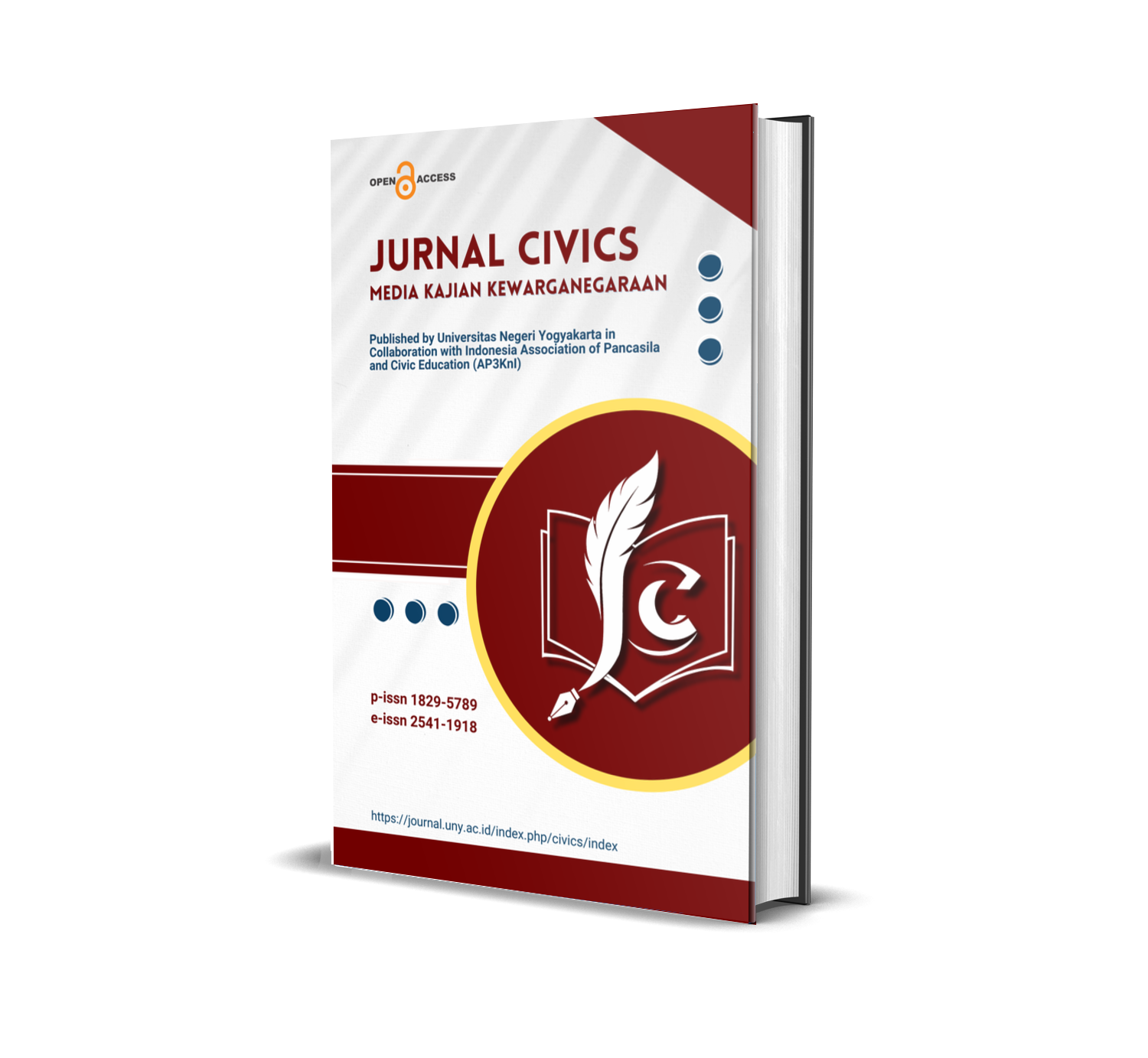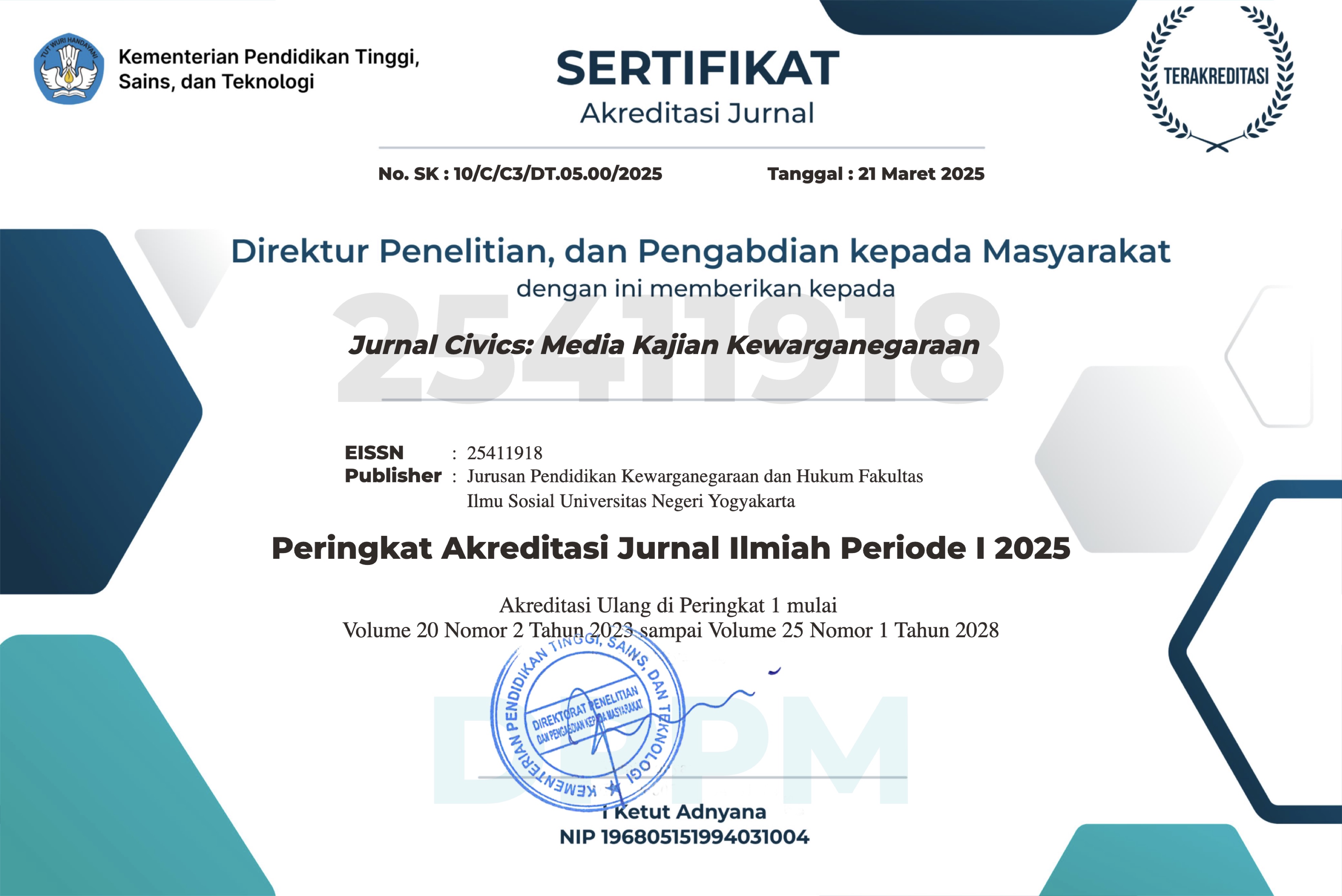Internalizing character education through javanese traditional dance to realize child-friendly school
DOI:
https://doi.org/10.21831/jc.v18i1.38452Keywords:
Javanese Traditional Dance, Character Education, Child-Friendly SchoolAbstract
The aims of the research are to (1) identify character education in various Javanese traditional dance, (2) to analyze the needs, output, problems, and learning objectives of child-friendly schools (CFS) in implementing character education based on regional dance, and (3) to identify types of Javanese traditional dance values. The methods of collecting the data used literary studies, interviews, surveys, observations, and documentation. In analyzing the data, the researchers employed Research & Development model. Model of regional cultural development based on character education is supported through a psychological, educative, and socio-cultural approach, with qualitative descriptive analysis implemented in 2020. The research findings show that (1) identification character education in various Javanese traditional dance, (2) the needs, output, problems, and learning objectives of child-friendly schools (CFS) in implementing character education based on regional dance, and (3) types of Javanese traditional dance values. The implication of the research is the implementation of character education for elementary school students.
References
Ambarwangi, S. (2014). Reog as means of students’ appreciation and creation in arts and culture based on the local wisdom. Harmonia: Journal of Arts Research and Education, 14(1), 37–45. https://doi.org/10.15294/harmonia.v14i1.2789
Ardhiani, Y. D. (2017). Sahita’s performance, satire of the life of Javanese women. International Journal of Creative and Arts Studies, 3(2), 63. https://doi.org/10.24821/ijcas.v3i2.1846
Arjo, I. D. (1989). Women’s dance among the Sundanese of West Java, Indonesia. Asian Theatre Journal, 6(2), 168. https://doi.org/10.2307/1124458
Christensen, P. (2013). Modernity and spirit possession in Java - horse dance as a threatened space of interpretation. In DORISEA Working Paper (2, Issue 2). https://doi.org/10.13140/RG.2.2.14834.50885
Dewi, T. K. S. (2018). Panji tradition in the jaranan jor and wayang timplong performance arts in East Java. ISLLAC : Journal of Intensive Studies on Language, Literature, Art, and Culture, 2(2), 13–20. https://doi.org/10.17977/um006v2i22018p013
Giyartini, R. (2018). Development of child education tourism through creative dance in West Java-based traditional games. Proceedings of the 5th International Conference on Community Development (AMCA 2018), 231(5th), 91–93. https://doi.org/10.2991/amca-18.2018.26
Irianto, A. M. (2016). The development of Jathilan performance as an adaptive strategy used by Javanese farmers. Harmonia: Journal of Arts Research and Education, 16(1), 38–48. https://doi.org/10.15294/harmonia.v16i1.5213
Jazuli, M. (2015). Aesthetics of prajuritan dance in Semarang regency. Harmonia: Journal of Arts Research and Education, 15(1), 16. https://doi.org/10.15294/harmonia.v15i1.3692
Malarsih, M. (2016). The tryout of dance teaching media in public school in the context of appreciation and creation learning. Harmonia: Journal of Arts Research and Education, 16(1), 95. https://doi.org/10.15294/harmonia.v16i1.4561
Marsim, A. N., Mulyanto, & Sudiyanto. (2019). Tuping dance learning at SMA Negeri 2 Kalianda South Lampung. International Conference on Arts Language and Culture (ICALC 2019), 421(Icalc 2019), 15–20. https://doi.org/10.2991/assehr.k.200323.003
Rapoport, E. (2018). Jathilan horse dance: Spirit possession beliefs and practices in the present-day Java. IKAT : The Indonesian Journal of Southeast Asian Studies, 2(1), 1. https://doi.org/10.22146/ikat.v2i1.37389
Rosmiati, S. H. (2018). Developing the nationalism character of young learners by using songs and traditional dances of Indonesia. International Conference on the Roles of Parents in Shaping Children’s Characters (ICECED), 287–292.
Saputra, R. G. C., Supriyadi, & Demartoto, A. (2019). Reproduction of Javanese dance in Soeryo Soemirat. International Journal of Education and Social Science Research, 2(2), 97–115. https://ijessr.com/link1.php?id=128
Sawitri, Sudardi, B., Abdullah, W., & Chaya, N. (2016). Innovations in Bedhaya dance in the age of globalization. Journal of Education and Social Sciences, 5(2), 318–323.
Setyaningrum, H., Asma, M. U., & Indriyani, P. D. (2018). Aesthetic review of Gandaria dance show in Rembang regency. The 2nd International Conference on Arts and Culture (ICONARC 2018), 276, 39–43. https://doi.org/10.2991/iconarc-18.2019.64
Shoji, M., Takafuji, Y., & Harada, T. (2020). Behavioral impact of disaster education: Evidence from a dance-based program in Indonesia. International Journal of Disaster Risk Reduction, 45(August 2019), 1–13. https://doi.org/10.1016/j.ijdrr.2020.101489
Slamet. (2019). The development of Jaranan Temanggungan as Indonesian intangible heritage. Arts and Design Studies, 77, 45–54. https://doi.org/10.7176/ADS/77-06
Soedarsono, R. (1972). Djawa dan Bali: Dua pusat perkembangan seni drama tradisional di indonesia. Gajah Mada University Press.
Supeni, S., Nurati, D. E., Sufa, F. F., & Jumintono. (2019). Character education development model based on regional culture. Journal of Advanced Research in Dynamical and Control Systems, 11(5 Special Issue), 673–683. https://www.jardcs.org/abstract.php?id=1193#
Wessing, R. (1999). A dance of life; The Seblang of Banyuwangi, Indonesia. Bijdragen Tot de Taal-, Land- En Volkenkunde / Journal of the Humanities and Social Sciences of Southeast Asia, 155(4), 644–682. https://doi.org/10.1163/22134379-90003865
Wisang, A. M. (2019). Cultural co-modification of Jaranan Turangga Yakso dance in Jaranan Festival in Trenggalek region. Journal of Advances in Social Science and Humanities, 5(1), 555–561. https://doi.org/10.15520/jassh51394
Downloads
Published
How to Cite
Issue
Section
Citation Check
License
The authors agree to transfer the transfer copyright of the article to The Jurnal Civics: Media Kajian Kewarganegaraan effective if and when the paper is accepted for publication.
Authors and other parties are bound to the Creative Commons Attribution-NonCommercial-ShareAlike 4.0 International License for the published articles, legal formal aspect of journal publication accessibility refers to Creative Commons Attribution-NonCommercial-ShareAlike 4.0 International License (CC BY-NC-SA).










